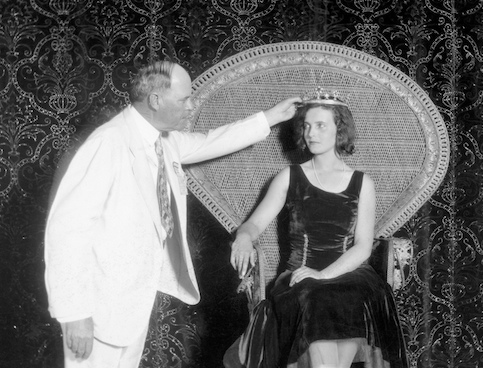Miss Universe 1929-Lisl Goldarbeiter, A Queen in Wien

Full Description
Lisl Goldarbeiter was an especially attractive Jewish teenage girl living in Vienna in the 1920s who eventually was crowned Austria’s first—and only—Miss Universe. Her Hungarian cousin and childhood friend, Maritz (Marci) Tenczer, had followed her to Vienna with two equal obsessions: his movie camera and Lisl. Now, with the distance of nearly eight decades, SFJFF Freedom of Expression Award winner Peter Forgacs (see page X) weaves together Tenczer’s vivid memories and the precious home movies of his gorgeous cousin into a film that says as much about the power of abiding unrequited love as about the dramatic life of Lisl herself.
It was cousin Marci who, unbeknownst to Lisl, had submitted her application to the prestigious pageant that she eventually won in Galveston, Texas. Soon the shy, serious girl was an international sensation, with the possibility of an American modeling career (we are treated to clips of one of the earliest talking films, a press conference with Lisl, who speaks in formal, halting English, charmingly undercut here by outtakes). Cousin Marci was with her all along, filming from a distance, proud and smitten. But Lisl married a bon vivant and returned to Europe during the gathering storm of fascism. Forgacs’s unique style of reworking of amateur home movies is here deployed to reveal not only a story of lives ruptured by forces of history, but also the triumph of survival and (big surprise) even the occasional happy ending.
Filmmaker Bio(s)
Director and narrator of Free Fall Oratorio, Peter Forgács was born in Hungary in 1950. He lives and works in Budapest as a media artist and scientist. Forgács graduated from the Academy of Find Art, Budapest, 1977. In the early 70's Forgács work was influenced by the Hungarian fluxus & concept art movement and by experimental theatre & filmmakers.
In 1983 he established the Private Film & Photo Archives Foundation for culture and art studies in Budapest. The archive now houses a collection of amateur films and snapshots spanning the 20th century Hungary.
Forgács is a scientific researcher at the Hungarian Sociological Institute of the Hungarian Academy of Sciences where he is part of the Private Film and Photo Research Project. As an independent film and video artist, Forgács works at the Béla Balázs film Studio where in 1978 he created his first 16mm film CHILDREN MOVIE and video tape I SEE THAT I LOOK. Since then he has collaborated with GROUP 180, a Hungarian minimal music group, where his fruitful cooperation with composer and musician Tibor Szemzö began. From 2008 Festival: Director, Hungary
Péter Forgács (1950) is a media artist and independent filmmaker based in Budapest, whose works have been exhibited world wide. Since 1978 he has made more than thirty films. He is best known for his Private Hungary series of award winning films based on home movies from the 1930s and 1960s, which document ordinary lives that were soon to be ruptured by an extraordinary historical trauma that occurs off screen.
In 1983, Forgács established the Private Photo & Film Archives Foundation (PPFA) in Budapest, a unique collection of amateur film footage and has made this material the raw data for his unique re-orchestrations of history.
In 2002 The Getty Research Institute held an exhibit of his installation The Danube Exodus: Rippling Currents of the River . His international debut came with the Bartos Family (1988), which was awarded the Grand Prix at the World Wide Video Festival in The Hague.
Since then, he has received several international festival awards in Budapest, Lisbon, Marseille, San Francisco, and Berlin, where he won the Prix Europe for Free Fall.
In the last decade, Forgács exhibited in Antwerp, Amsterdam, Tokyo, Prague, Bochum, Sao Paolo, New York, Rome, Graz, Fellbach, Warsaw, Krakow, Amsterdam, Newcastle, Ostrava, Madrid, Barcelona, Karlsruhe, Brugge, Los Angeles, Den Hague and Vienna. Various public collections, museums and universities keep Forgács highly recognized works.
Filmography:
2005 El Perro Negro
2004 Mutual Analysis
2003 Do you really love me? The HungAryan installation
2003 Der Kaiser auf dem Spaziergang - light & image project
2002 The Bishop’s Garden - Private Hungary 14
2001 A Bibó Reader - Private Hungary 13
1999 Angelos’ Film
1998 The Danube Exodus
1997 The Maelstrom - A Family Chronic
1997 Kádár’s Kiss - Private Hungary 12
1997 Class Lot - Private Hungary 11
1996 Free Fall - Private Hungary 10
1996 Pauer Pseudo
1996 The Land of Nothing - Private Hungary 9
1994 Meanwhile Somewhere 1940-43...
1994 The Notes of a Lady - Private Hungary 8
1994 Hungarian Totem (video - 26min)
1993 Conversations on Psychoanalysis - documentary series 5/5
1 Freud & Vienna
2 Sándor Ferenczi & the Budapest School of Psychoanalysis
3 The Psychoanalytic View of Man
4 Psychoanalysis & Society
5 Psychoanalysis as Therapy
1993 Simply Happy - with Albert Wulffers
1993 Culture Shavings
1992 Bourgeoisie Dictionary - Private Hungary 7
1992 Wittgenstein Tractatus - INTERLUDE series
1991 Arizona diary - with poet György Petri
1991 Photographed by László Dudás - Private Hungary 6
1991 D-FILM - Private Hungary 5
1991 Márai Herbal - INTERLUDE series
1990 The Diary of Mr. N. - Private Hungary 4
1989 Either - Or - Private Hungary 3
1989 Dusi & Jenõ - Private Hungary 2
1988 The Bartos Family - Private Hungary 1
1987 Episodes from the Life of Professor M.F.
1986 The Portrait of Leopold Szondi
1985 Spinoza Rückwertz
1985 Iron Age
1985 Golden Age video
1978 I See That I Look
Art works in art collections:
Museum of Modern Art, New York, USA
Centre Georges Pompidou, Paris, Frankreich
Pacific Film Archives, Berkeley, USA
Hungarian National Gallery, Budapest, Ungarn
Director(s)
Country(ies)
Language(s)
w/English Subtitle
Release Year
Festival Year(s)
Running Time
70
